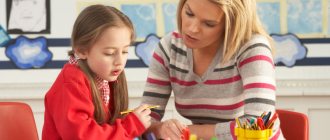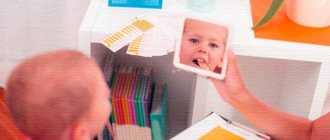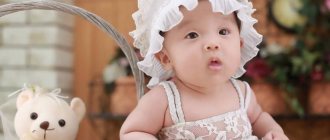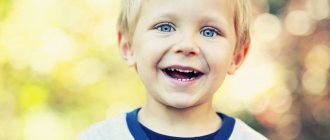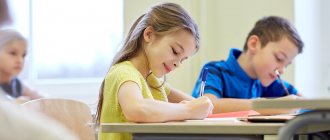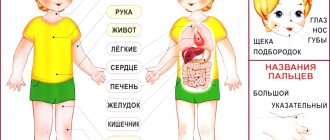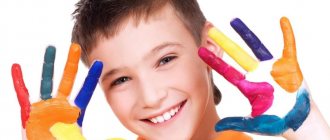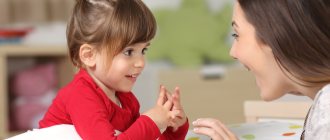Article:
It's no secret that the number of children with disabilities is currently growing, including children with SLD.
And therefore, for us, specialists - speech therapists, the creation of an optimal system of comprehensive assistance to children with STD in mastering the preschool education program and positive social adaptation to the next age level - school, is of particular relevance. Organizing the activities of children with speech disorders requires a special approach. Often, neither the desire of a speech therapist nor the knowledge of speech correction techniques is enough to obtain the desired result when correcting speech deficiencies. Therefore, specialists are forced to look for the most effective ways of education and training.
It is known that the use of various non-traditional methods and techniques by speech therapists in their work supports the child’s cognitive activity, prevents fatigue, and, in general, increases the effectiveness of speech therapy work. And one of these methods is bioenergoplasty.
Bioenergoplasty is a combination of movements of the organs of the articulatory apparatus with movements of the hands and fingers.
In speech therapy practice, a significant role is played by the development in children of kinesthetic sensations of the organs of articulation, which allow them to feel the different positions of the organs of the articulatory apparatus.
And the use of a method such as bioenergoplasty helps specialists develop these sensations in children.
This method is advisable to use in speech therapy practice, since by developing fine motor skills and thereby activating the corresponding parts of the brain, we activate neighboring areas responsible for speech.
Research by domestic physiologists (Marionilla Maksimovna Koltsova, Vladimir Mikhailovich Bekhterev, Alexey Alekseevich Leontyev) confirms the positive effect of fine movements of the fingers on the functioning of the speech zones of the cerebral cortex.
The basic principle of bioenergoplasty is the conjugate work of the hands, fingers and articulatory apparatus, where hand movements imitate the movements of the speech apparatus.
Corrective work using the “Bioenergoplasty” method arouses children’s interest in speech therapy classes. When teaching children, the speech therapist uses various game characters, gloves, counting, music, poetry, and presentation materials.
Each speech therapist can develop an acceptable set of exercises aimed at producing sounds of different groups using the “Bioenergoplasty” method. Exercise sets may vary in complexity depending on the age of the children. It is also possible to use elements of bioenergoplastics as warm-ups and physical exercises in any type of activity. The proposed method can be used by educators in correctional work.
Complex of articulatory gymnastics,
aimed at producing whistling sounds using the “Bioenergoplastika” method
When performing exercises, children sit on chairs opposite the speech therapist. The children's arms are spread to the sides, elbows bent. Each exercise is performed for 6 - 8 seconds. After completing each exercise, children are asked to lower their hands and relax.
Exercise for the tongue “Hippopotamus” - the exercise is accompanied by squeezing and unclenching the hands;
Exercise for the tongue “Smile” - fingers clenched into a fist;
Exercise for the tongue “Tube” - fingers closed, extended forward;
Alternate exercises “Smile” and “Pipe” 2-3 times.
Exercise for the tongue “Shovel” - the hands are relaxed and lowered;
Exercise for the tongue “Groove” - the hands take the shape of a “boat” (fingers are closed, slightly bent, fingertips are adjacent to each other);
Exercise for the tongue “Slide” - the hand takes the shape of a slide;
Alternate exercises “Groove” and “Slide” 2-3 times.
The use of bioenergoplastics in the correction of sound pronunciation in preschool children
During the preschool period, the development and formation of the child’s speech occurs. This is a necessary condition for the full development of the individual. Currently, there is a significant increase in the number of children with speech pathology.
Therefore, one of the urgent tasks is to increase the efficiency of the process of correction of speech disorders.
The most common problem for children of older preschool age is a violation of sound pronunciation. Deficiencies in sound pronunciation can cause deviations in the development of mental processes such as memory, thinking, lead to dyslexia and dysgraphia, and also form an inferiority complex, expressed in communication difficulties. The initial stage in correcting sound pronunciation is performing articulatory gymnastics.
The purpose of articulation gymnastics:
- strengthening the muscles of the articulatory apparatus;
- development of strength, mobility and accuracy of movements of the organs of articulation;
- combining simple movements into complex articulation patterns;
However, daily gymnastics classes, unfortunately, reduce children’s interest in this process, which in turn leads to a decrease in the effectiveness of performing articulation exercises. [2, from 4]
Scientists have long noted the connection between a child’s intellectual and speech development and the degree of development of his finger motor skills. In the research of scientists from the Institute of Physiology of Children and Adolescents of the Academy of Sciences, M. M. Koltsova, a connection was noted between the intellectual and speech development of a child and the degree of development of his finger motor skills. The speech area is formed under the influence of impulses coming from the fingers. (M. M. Koltsova, A. N. Pfafendrot, L. V. Lopatina, N. V. Serebryakova, V. V. Tsvintarny, V. V. Konovalenko).
All authors note the interdependence of speech and motor activity, the stimulating role of training fine finger movements. Therefore, a new and interesting direction of this work is bioenergoplastics. A. V. Yastrebova and O. I. Lazarenko suggested using elements of bioenergoplastics when working with children [7]
The origins of bioenergoplastics come from the ancient traditions of yoga, where hastas are used - “gestures of the hands.” These exercises have an effect on the physical and mental state of a person.
The term “bioenergoplastics” consists of two words - bioenergy and plastic. According to I.V. Kuris, bioenergy is the energy that is inside a person. [6]
“Bioenergoplastics” includes 3 basic concepts: bio-man, as a biological object; energy is the force required to perform certain actions; plasticity is a movement associated with plasticity, which is characterized by continuity, energetic fullness, and emotional expressiveness. [5]
Bioenergoplasty is a combination of movements of the articulatory apparatus with movements of the hand. When performing an articulation exercise, the hand shows where and in what position the tongue, lower jaw or lips are located. [2, p. 4]. The working palm repeatedly amplifies the impulses going to the cerebral cortex from the tongue. Performing articulatory exercises and rhythmic movements of the hand and fingers will inductively lead to excitation in the speech centers of the brain and a sharp increase in the coordinated activity of speech zones, which will ultimately improve articulatory motor skills, and therefore improve sound pronunciation.
Exercises with bioenergoplasty are carried out only in individual lessons. The quality and duration of mastering articulatory gymnastics with bioenergoplasty depends on the individual characteristics of the child.
The implementation of the exercise system involves several stages.
Stage 1 - diagnostic. An examination of the structure and mobility of the articulation organs is carried out, and a set of exercises is selected taking into account impaired sounds. The child repeats articulation exercises after the speech therapist, but the hand does not turn on.
Stage 2 - preparatory. Articulation gymnastics is performed using traditional methods. The teacher includes his leading hand in the exercises. The child's hand does not turn on.
Stage 3 is the main one. Performing articulation gymnastics using traditional methods, getting acquainted with glove puppets. The child's leading hand is turned on, then the other hand. Gradually, the child performs articulation exercises and at the same time, with the movement of both hands in toy gloves, imitates and repeats the movement of the articulatory apparatus. The teacher monitors the rhythmic execution of the exercises. For this purpose, counting, music, and poetic lines are used.
Stage 4 is the final stage. When the child has completely mastered the exercises, the teacher tells a fairy tale, and the child independently performs articulation exercises with gloved hand movements.
During the exercises, glove dolls are put on the child's hands - the girl Buba and the boy Bob. To make dolls, you need to take a pair of gloves, attach eyes on the outside and, if desired, a hat, bow, etc.
Children love fairy tales very much. Using a fairy tale to perform articulatory gymnastics is another way to avoid monotony and monotony. Listening to a fairy tale, children become not only performers of exercises, but also active participants in the fabulous journey of the tongue.
The purpose of fairy tales is to combine the movements of the hands and organs of articulation into a complex necessary to produce a certain group of sounds. [2, p. 231].
The glove puppet acts as a symbol of the tongue. Dolls have a cognitive and communicative function. Fairytale events help overcome the fear of not being able to do this or that exercise. The child identifies himself with the doll and will not overreact to his failure.
In order to introduce bioenergoplastics into the practice of a kindergarten, a project was developed. During the implementation of the project, literature was studied, meetings, questionnaires and consultations were held for parents and educators. A developmental environment has been created - a card index of drawings of manual poses with a description of the movements of the hand and fingers and organs of articulation; card index of bio-tales; glove puppets were made.
Parents and teachers took an active part in making the dolls; everyone showed imagination and creativity.
Glove puppets are very diverse in appearance - there are girls and boys, bear animals, hares, etc. Each has a mandatory element - eyes. Some have an additional attribute - hats, bows, ears. The child is given the right to choose gloves. The teacher selects a fairy tale with the necessary set of exercises.
Experience has shown that the simultaneous work of hands and tongue makes it much easier for children to master a new exercise. At the same time, children themselves try to come up with movements for their hands if the adult does not provide an example. In addition, such gymnastics of the tongue and fingers can be carried out in any conditions: in bed, while walking.
Synchronizing work on speech and fine motor skills allows you to quickly remove the visual support - the mirror - and move on to performing exercises based on sensations. Therefore, the process of introducing sounds into speech is more interesting and faster.
Bioenergoplasty helps to increase motivational readiness, maintain a child’s interest and performance for a long time.
Value and advantages of the technology used:
- accessibility (financial costs are small)
- ease of use (use by teachers and parents)
- variability, creative approach (use of poems, fairy tales, design of glove puppets)
The use of bioenergoplastics has been successfully tested in a kindergarten for 3 years.
Results of using bioenergoplastics:
positive dynamics in the development of articulatory and finger motor skills, the development of memory, attention, thinking, sense of rhythm, orientation in space;
- significant facilitation of production and introduction of sounds into speech.
ensuring the child’s success;
- hands and fingers acquire strength, good mobility and flexibility, and this further facilitates mastering the skill of writing.
building continuity in the work of all interested participants in the educational space in correcting the speech of children, teachers, and parents.
- a beneficial effect on the child’s psyche, on his physical and mental health.
Bioenergoplasty is a new, interesting, effective and promising method of correctional speech therapy work.
Literature:
- Bolshakova S. E. “Method of manual support for motor alalia” // Journal “Speech therapist” No. 8, 2012, pp. 12–23.
- Bushlyakova R. G. Articulatory gymnastics with bioenergoplasty. - M.: Detstvo-Press, 2011.
- Zaitseva I. Yu. The influence of bioenergoplastics classes on the speech development of preschool children. — Access mode: https://festival. 1september.ru/articles/103050
- Kosinova E. A. Lessons for speech development. - M.: Eksmo, 2007.
- Novotvortseva N.V. Development of children’s speech. - Yaroslavl: Academy of Development, 1997.
- About yoga dance or bioenergoplastika.- Access mode https://www.bioenergoplastika.ru//
- Yastrebova A.V. I want to go to school: a system of exercises that shape speech and thinking activity and the culture of children’s oral speech. - M.: Arkti, 1999.
"Bioenergoplasty"
Hand pose:
all exercises are performed first with one hand, then with the other, and finally with both hands together.
The pace of execution is slow. Gradually the pace of execution increases. Children are guided by the pace set by the adult, his counting and the pattern of hand movement.
Flashlights.
Place your palms in front of you, straightening and spreading your fingers. Clench and unclench your fingers on both hands at the same time, accompanying the movements with your mouth, opening and closing your mouth.
Boat.
Both palms are placed on the edge and connected by a “bucket”, the thumbs are pressed to the palms. “The boat floats”, at the same time the tongue slides across the lips from one corner of the lip to the other.
Steamboat.
Both palms are connected by a “bucket”, all fingers, except the thumbs, are directed away from you, and the thumbs are raised up and connected - this is a “pipe”, at the same time moving your hands to the sides, as if swaying slightly, clicking your lips.
River and fish.
Straightened palms pressed against each other. Fingers pointing to the side
"Push". Turn your closed palms to the right and left, imitating the movement of a fish’s tail, while the tongue rests on one or the other cheek.
Trees.
Place your hands in front of you, palms facing you. The fingers are spread apart and tense. The tongue rests on the upper lip. After completing the exercise, shake your hands and wag your tongue.
Roots.
Palms down. The fingers are spread apart and tense. Hold your hands and tongue resting on your lower lip in this position for a count of five to ten. After the exercise, relax your hands, shake your hands and wag your tongue.
The bird drinks some water.
Putting your fingers together in a pinch is a beak. Without lifting your elbow from the table,
touch the table with your beak. Next - imitate the movements of the bird: grab the “water”, raise the “head”, click your beak while making your lips a tube and move them.
The bird is flying.
Place your hands in front of you (palms facing you). Interlace your thumbs – this is the “head” of the bird. The remaining fingers are “wings”. Wave them, “wings” up, stick out your tongue, “wings” down, remove your tongue.
Flower.
The palms are raised up, the fingers form a “bud”, the bases of the hands are pressed against each other. The flower is blooming: we simultaneously spread our fingers to the sides, imitating the sound -a- with our mouth, without pronouncing it, then bring our fingers together, imitating the sound -u- with our mouth, without pronouncing it.
Kitty.
Clench your two palms into fists at the same time and place them on the table, then simultaneously straighten and press your palms to the table. The cat gets angry when her fists are clenched; when her palms are pressed to the table, the cat smiles.
Gates.
Place your palms on the edge, fingers facing each other - the “gate” is closed, the mouth is closed. The gate opens - the mouth opens wide.
Bioenergetics in the work of a speech therapist.
Author: Afanasyeva Vera Anatolyevna
teacher-speech therapist MBOU "Elementary school - kindergarten" of the city of Safonovo, Smolensk region
Bioenergetics in the work of a speech therapist.
Bioenergoplasty in the work of a speech therapist
When pronouncing sounds, the organs of the speech apparatus take a special position, which is characteristic of a certain sound. To form the necessary and complete articulation patterns, articulatory gymnastics is used, which consists of a set of special exercises. Performing gymnastics strengthens the muscles of the speech apparatus, while the movements of the tongue and lips become precise, strong, and confident. Unfortunately, daily gymnastics classes reduce children's interest in this process, which leads to a decrease in the effectiveness of performing articulation exercises.
The success of speech therapy work largely depends on the competent organization of correctional work, the teacher’s ability to involve the child in a variety of activities that stimulate interest and high cognitive activity. And I turned to an innovative method of performing articulatory gymnastics - bioenergoplasty. The author of this technique is Candidate of Pedagogical Sciences Kuris Irina Viktorovna.
Bioenergoplastics includes three basic concepts:
“bio” - a person as a biological object;
“energy” is the force required to perform certain actions;
“plastic” - smooth movements of the arms and body.
Bioenergoplasty
- This is a combination of movements of the articulatory apparatus with movements of the hand. Body movements, joint movements of the hand and the articulatory apparatus, if they are plastic, relaxed and free, help to activate the natural distribution of bioenergy in the body. This has an extremely beneficial effect on the activation of children’s intellectual activity, develops coordination of movements and fine motor skills (according to A.V. Yastrebova and O.V. Lazarenko)
Elements of bioenergoplastics can also be found in systems for developing intelligence using kinesiology methods (massage of the hands, neck, shoulders, finger motor skills, articulatory gymnastics). This is another argument in favor of the use of bioenergoplasty, since under the influence of kinesiological training, positive structural changes in the body are noted: the work of the cerebral hemispheres is synchronized, abilities develop, memory, attention, thinking, and speech improve.
In my work, I set myself the following goal - to increase the efficiency of work to correct impaired sounds in children with reduced and impaired kinesthetic sensations through the use of elements of bioenergoplasty.
I have developed and tested the pedagogical technology “Introducing elements of bioenergoplastics in classes with children of senior preschool age,” which includes the following components:
- Development of special movements of the hands and fingers for each articulation exercise.
- Development of a complex of articulatory finger gymnastics using fairy tales and poems.
- Designing a work system for bioenergoplastics classes in the form of a long-term plan for lexical topics.
- A selection of musical accompaniment for bioenergoplastics classes.
- Systematization of poetic texts for use when performing articulation-finger exercises.
- Identification of the effectiveness of correctional pedagogical work.
The introduction of a system of games and exercises in bioenergoplastics included several stages
: diagnostic, preparatory, main and final.
At the diagnostic stage, an examination of the structure and mobility of the articulation organs was carried out, and a set of articulation exercises was selected.
At the preparatory stage, the child was introduced to articulation exercises; the work was carried out in front of a mirror. The teacher accompanied the articulation exercises with movements of the leading hand, and the student involuntarily remembered the movements; his hand was not involved in performing the exercise.
At the main stage, the teacher-speech therapist performed articulation exercises together with the child and accompanied the demonstration by moving the hand on the bottom of the arm. The child learned to perform movements with the dominant hand simultaneously with articulation exercises, and the second hand was gradually involved.
To implement this stage, special methods, techniques and teaching aids were selected:
- Using a mitten doll.
- The application of the doll therapy method is through the use of speech therapy dolls.
- Using a manual tongue model (red mitten without a finger). A speech therapist or a child, manipulating such a “tongue”-mitten, demonstrates articulatory movements in combination with the work of the hand.
- The use of children's gloves when performing articulatory-finger gymnastics.
- Accompanying articulation-finger exercises with poetic texts. Poetic texts increased children's interest, developed memory and attention.
- Using the music therapy method. Positive emotional arousal from the sound of pleasant melodies enhances attention and tones the central nervous system. That is why background music was used for bioenergoplastics classes.
- The use of the fairy tale therapy method—accompanying articulatory finger gymnastics with fairy tales—helped relieve physical and mental stress in children, formed positive self-esteem and self-confidence, contributed to the development of the emotional sphere and increased the vocabulary of children.
At the final stage, the child, who had completely mastered the exercises, independently performed articulation exercises with hand movements.
The bioenergoplastics complex is designed for the entire year of study; you can work according to the scheme of the complex, complicating and breaking it up, and also use the elements of bioenergoplastics as warm-ups and physical exercises in any type of activity.
When selecting teaching methods and means, the capabilities, developmental characteristics and needs of each child were taken into account, that is, the principle of individualization of education
.
In older preschool age, it is very important for children to assert themselves so that adults recognize them as full participants in the educational process, that is, the principle of supporting children’s initiative is taken into account.
The educational material was presented in such a way that the children independently “thought out” the solution to the key problem. Thus, the principle of activity was fulfilled.
The principle of combining play and learning in the child’s activities was observed.
. The complexity and novelty of the material presented were taken into account, the process of cognition was reflected in a variety of children's activities and was combined with the main children's activity - play.
The child was perceived not as an object of pedagogical efforts, but as a subject of the educational process. Individual, subgroup and frontal classes were structured as a joint activity, and the teacher and therapist and the children were equal partners in this activity, that is, the principle of recognizing each child as a full participant in the educational process was observed.
The consolidation of the efforts of various specialists in the field of psychology, medicine, pedagogy and correctional pedagogy made it possible to provide a system of comprehensive psychological, medical and pedagogical support and effectively solve the problems of a child with speech disorders, that is, the principle of integration of the efforts of specialists was taken into account.
Education will not bring any success if it is “involved” in fear of adults and suppression of the child’s personality. Therefore, one of the important principles is the principle of psychological comfort.
. Any pressure on children, coercion to perform activities, condemnation, or evaluation is excluded from the work.
When organizing interaction with the parents of the pupils, the social status of the family was taken into account, efforts were aimed at creating a friendly, psychologically comfortable atmosphere in the group, establishing mutual understanding and creating conditions for effective cooperation, that is, the principle of cooperation between the teacher-speech therapist and the families of the pupils was observed.
The “Strategy for the Development of Education in the Russian Federation for the Period until 2025” states that “support for family education includes ... creating conditions for expanding family participation in the educational activities of organizations carrying out educational activities and working with children.”
Analysis of the correctional work carried out with children allows us to conclude that bioenergoplasty is an integral part of speech therapy work, both for the development of the articulatory apparatus, speech breathing and the complex: speech and movement, as well as for emotional and mental balance and perfection.
Synchronizing work on speech and fine motor skills reduces the time of training by half, not only without reducing, but even enhancing their effectiveness, and allows you to quickly remove the visual support - the mirror and move on to performing exercises based on sensations.
The use of bioenergoplasty effectively accelerates the correction of disturbed sounds in children with reduced and impaired kinesthetic sensations, since the working palm greatly enhances the impulses going to the cerebral cortex from the tongue.
The Federal State Standard for Preschool Education highlights the section “Requirements for the results of children mastering the basic educational program of preschool education.” These requirements “are presented in the form of targets for preschool education, which represent age-specific characteristics of the child’s possible achievements at the stage of completing the level of preschool education.”
Thus, a child who graduates from a speech therapy group:
- individual and age-related potential is maximized - speech disorders are corrected: speech is correct, clear, there are no violations in the phonemic structure of speech and sound pronunciation;
- gross and fine motor skills are developed, he can control and manage his movements;
— coordinates itself in the “eye-hand” system;
- owns the means of cognitive and speech activity;
— a line of voluntary behavior has been formed;
- knows how to communicate and collaborate with adults and peers.
Such characteristics “are necessary prerequisites for the transition to the next level of primary education, successful adaptation to living conditions at school and the requirements of the educational process.”
Bioenergoplastika - health-saving technology in preschool educational institutions
Anastasia
Bioenergoplastika - health-saving technology in preschool educational institutions
The more confidence in the movement of a child’s hand, the brighter the child’s speech!
V. A. Sukhomlinsky
What is bioenergoplasty ?
Bioenergoplastics includes three basic concepts:
"bio"
— man as a biological object;
"energy"
- the force required to perform certain actions;
"plastic"
- smooth movements of the body and hands, which are characterized by continuity, energy fullness, and emotional expressiveness.
Bioenergoplasty is a combination of movements of the articulatory apparatus with movements of the hand.
Research by domestic physiologists (M. M. Koltsova, V. M. Bekhterev, A. A. Leontyev, etc.)
confirm the connection between hand development and brain development. In the human brain, the centers responsible for speech and finger movements are located very close. By stimulating fine motor skills and thereby activating the corresponding parts of the brain, we also activate neighboring areas responsible for speech. The relationship between the motor and speech zones is manifested in the fact that a person who has difficulty choosing the right word helps himself with gestures, and vice versa: a child who is concentrating on drawing or writing involuntarily sticks out his tongue.
Bioenergoplasty synchronizes the functioning of the cerebral hemispheres, improving attention, memory, thinking, and speech.
The principle of bioenergoplasty is the conjugate work of the fingers and hands and the articulatory apparatus, the movements of the hands imitate the movements of the speech apparatus. A set of exercises, according to the principle of bioenergoplasty , promotes the development of mobility of the articulatory apparatus, which, in turn, affects the accuracy in mastering articulatory patterns.
Stages of work using bioenergoplastics :
— Diagnostic (history collection, examination of general, fine and articulatory motor skills)
— Emotional (creating a positive attitude)
— Basic (practicing articulation exercises followed by connecting the leading hand, and then the second hand).
Features of working with the use of bioenergoplastics :
Introducing articulation exercises using standard methods. Practice it in front of the mirror. The hand is not involved in the exercise. The teacher demonstrating the exercise accompanies the demonstration with one hand.
The leading hand joins the articulation exercise.
The movements of the hand should become relaxed and smooth.
The second hand gradually joins in. Thus, the child performs an articulatory exercise or holds a pose with simultaneous movements of both hands, which imitate the movements of the articulatory apparatus.
In order to increase the child’s interest in such exercises, a game character is used (for example, “Magic Gloves”
,
“Monkey”
, counting, music, poetry.
Advantages of bioenergoplasty :
— optimizes the psychological basis of speech;
— improves the child’s motor abilities in all respects;
— promotes the correction of sound pronunciation and phonemic processes;
— synchronization of speech and fine motor skills reduces the time of classes and enhances their effectiveness;
- allows you to quickly remove the visual support - the mirror and move on to performing exercises based on sensations.
The proposed direction can be used by educators when conducting events in the educational field of “Communication”.
The use of bioenergoplastics in preschool educational institutions helps to increase the performance of pupils, activates cognitive interest, has a beneficial effect on the psyche of a preschooler, on his state of physical and mental health , and ensures the child’s success in the process of educational activities.
Examples of articulation exercises using bioenergoplasty :
All exercises can be done sitting or standing. Basic source
the position is almost the same: the head is straight, the lips and teeth are closed, the arms are bent at the elbows at chest level.
Hand pose: All exercises are performed first with one hand, then with the other, and finally with both hands together.
The pace of execution is slow. Gradually the pace of execution increases. Children
are guided by the pace set by the adult, his counting and the pattern of hand movement.
Flashlights. Place your palms in front of you, straightening and spreading your fingers. Clench and unclench the fingers on both hands at the same time, accompanying the movements with your mouth, opening and closing your mouth.
Boat. Both palms are placed on edge and connected by a “bucket”
, thumbs pressed to palms.
“The boat is sailing”
, at the same time the tongue slides across the lips from one corner of the lip to the other.
Steamboat. Both palms are connected by a “bucket”
, all fingers, except the thumbs, are directed away from you
,
and the thumbs are raised up and connected - this is
a “pipe”
, at the same time moving your hands to the sides, as if swaying slightly, clicking your lips.
River and fish. Straightened palms pressed against each other. Fingers pointing away from you
. Turn your closed palms to the right and left, imitating the movement of a fish with its tail, while the tongue rests on one or the other cheek.
Trees. Place your hands in front of you, palms facing you. The fingers are spread apart and tense. The tongue rests on the upper lip. After completing the exercise, shake your hands and wiggle your tongue.
The bird drinks some water. Fold your fingers together
- this is the beak.
Without lifting your elbow from the table, with your beak
.
Next, imitate the movements of the bird: grab the “water”
, raise
the “head”
, click your beak, make your lips into a tube and move them.
